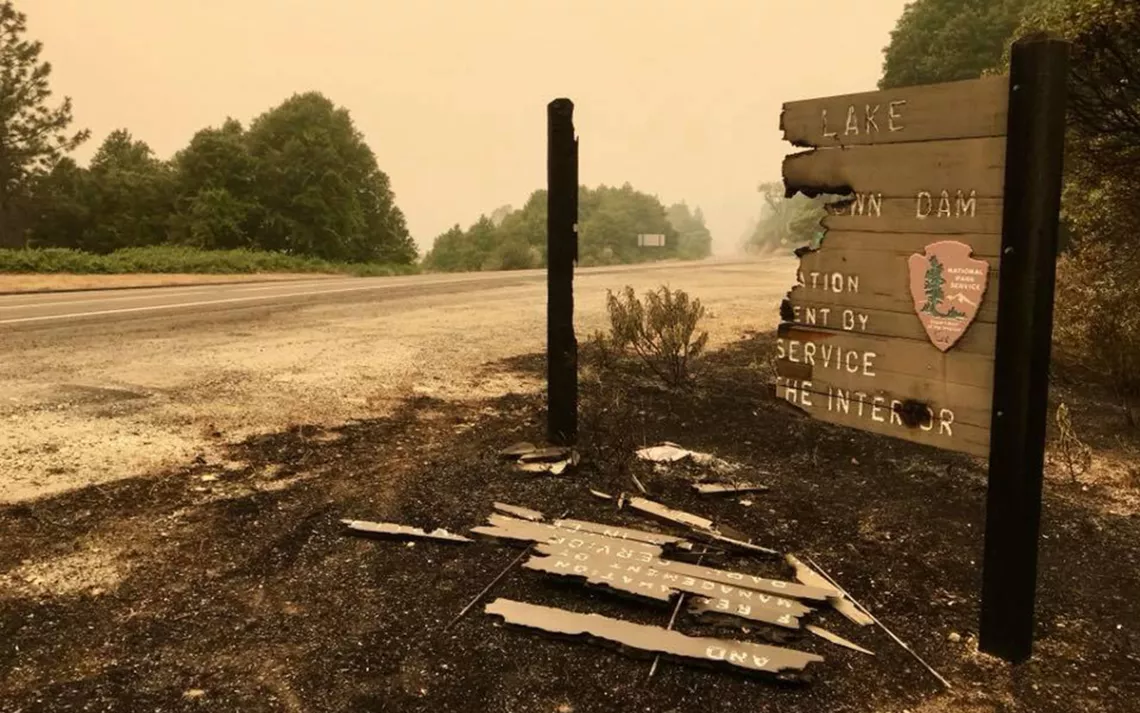How Do You Cope When Your Favorite Places Are Gone?
A requiem for what we lost to California’s climate-driven wildfires

Photo courtesy of the National Park Service
For most of my life, wildfires were few and skies were smoke-free. I had the sense that the places I loved to hike would always be there. Warm summer days were all about cool, alluring mountain lakes and ridges and peaks that offered far vistas.
I began hiking the mountains of upper Northern California as a teen in the 1970s. I was vaguely aware of wildfires, but they were infrequent events, a short-term haze on the horizon that quickly disappeared and had no impact on my wilderness wanderings.
I’ve now been writing hiking guidebooks about Northern California for 30 years. When researching the first edition of 100 Classic Hikes: Northern California in the early 1990s, I saw only a few isolated burned areas along the trails I included in the book. By the time the fourth edition came out in spring 2018, I’d had to replace several hikes that had suffered from fires in the intervening years. I accepted the growing prevalence of fire in the wild areas I love; the amount burned was small and not in my favorite places.
So, like most Californians, I was unprepared for the onslaught of flames that engulfed the state from 2018 through 2021, burning millions of acres and thousands of buildings and ending hundreds of lives. The environmental devastation and the disruption of people’s lives have been enormous. On a personal level, I’ve lost areas where I have felt my deepest connection to nature and been most at peace.
The 2018 Carr Fire in Shasta County near Redding was the first jolt. It tore through nearly all of Whiskeytown Lake National Recreation Area. My family spent many summer days at that lake; it’s where I learned to swim and sail and where I did many of my first hikes. Winds pushed the Carr Fire all over western Shasta County, torching more trails and hundreds of homes, and killing much of the vegetation on the mountains west of Redding. The skyline I’d grown up with, once vibrant with pine, fir, and cedar, now shows only the dark colors of their skeletons. Several of my favorite trails near Whiskeytown Lake are still closed.
Then came 2021, one of the worst years yet. August saw so many major fires that I had difficulty keeping them all straight. I focused on the ones burning nearest me and the people I love—and on those burning my favorite trails. The Dixie Fire began in the northern Sierra and exploded north, eventually reaching Lassen Volcanic National Park. I’ve been hiking in the park for nearly my entire life, and I return year after year to climb its steep-sided volcanoes and explore its forests, meadows, and lakes. But much of the park burned, with only the far western portion untouched.

Photo by Cory Poole

Photo by Cory Poole
The River Complex burned the Trinity Alps Wilderness and adjacent lands in far Northern California. The more remote and less popular trails in the northern Trinities have been go-to hikes that I often do twice a year or more. While they lack the dramatic scenery of the more famous parts of the wilderness to the south, I have come to love the ridges of metamorphic rock, the forest shade, the silky feel of cold, clear water when I swim the glacial lakes. And—important to me—I have often found solitude there. Now much of it is gone.
I mourn the loss of these beautiful wild places. I still don’t know the full extent of the damage to them, but I do know it is extensive. Yes, they may fully recover, but not in my lifetime. At times I grieve their loss as I have for loved ones who have died.
Two concepts help me deal with life’s trials, including the devastation of wildfires. The first is the Buddhist concept of impermanence: All things change with time; everything that is alive now will someday be dead, even as new life appears. It helps me accept the present moment as best as I can.
The other concept comes from a modern interpretation by the philosopher William B. Irvine of the ancient Greco-Roman philosophy of Stoicism called the trichotomy of control. Our thoughts and actions are in our control, while most of what happens in the world is not. A third, very important category is things that are partially in our control, that we can potentially influence. On a personal level, I minimize my contribution to climate change, which is a major cause of the recent spate of wildfires. Professionally, I educate people about how to behave in the outdoors. That starts, unfortunately, with foregoing all campfires, even when and where they're allowed, because too few people follow proper safety guidelines. I also encourage policymakers to listen to wildfire experts about the best solutions for preventing and combating wildfires and to provide the funding needed to implement those solutions.
I also continue to encourage people to walk the trails, so there will eventually be a fifth edition of 100 Classic Hikes: Northern California. I’ll leave out some favorites from the past, the ones too scarred. I’ll include others, knowing—and accepting—that fire may eventually reach many of these.
In the face of these losses, I take comfort knowing that there will always be natural beauty in the world. I will hike primarily in areas that haven’t burned, and I will strive to be mindful of and grateful for the day-to-day nature around me: a blue jay on a branch, autumn gold in the oaks, the leap of a jackrabbit, the new green of the coming spring.
 The Magazine of The Sierra Club
The Magazine of The Sierra Club



